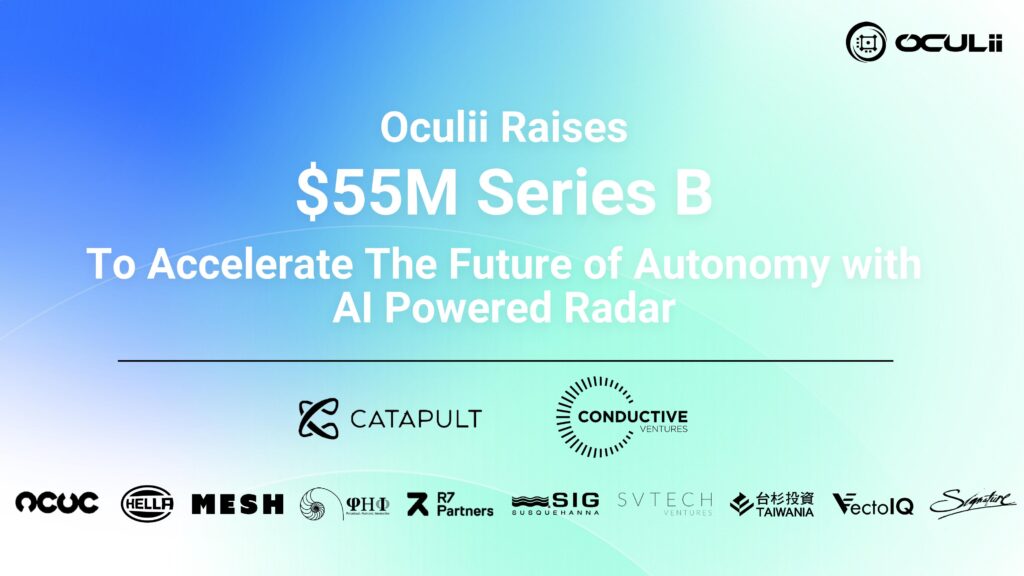Oculii, which provides advanced AI software for radar perception, has raised US$55m in a Series B funding round co-led by Catapult Ventures and Conductive Ventures, with participation from Taiwania Capital, Susquehanna International Group (SIG), HELLA Ventures, PHI-Zoyi Capital, R7 Partners, VectoIQ, ACVC Partners, Mesh Ventures, SV Tech Ventures, Schox Ventures and Signature Bank. The new round of financing brings Oculii’s total funding amount to US$75m.
The new funding follows Oculii’s launch of its Eagle and Falcon highest-resolution radars, powered by the company’s AI-enabled Virtual Aperture Imaging (VAI) software platform, which can deliver up to a 100x increase in resolution on any radar hardware platform – enabling high performance, all-weather perception using existing radar sensors that are market-proven and widely deployed.
Oculii says its AI software technology has already been licensed by some of the world’s leading automotive radar Tier 1s and OEMs, providing them with a scalable solution that significantly enhances the commercial automotive advanced driver assistance systems (ADAS) available today, and unlocks fully autonomous driving in the future.
With its low cost, high reliability and all-weather vision, radar has transformed the automotive industry. It powers innovations such as emergency braking, blindspot detection and parking-assist systems. However, due to radar’s limited resolution, it has fallen short of the automotive industry’s autonomy needs. Improving radar performance is possible by adding more antennas to sensors, but this approach significantly increases cost, size and power consumption.
Oculii’s revolutionary approach uses AI software to solve this hardware problem. Its AI-powered Virtual Aperture Imaging platform dynamically sends out an adaptive, phase-modulated waveform that changes in real-time with the environment and then encodes that data over time, increasing the resolution of any radar hardware by up to 100x.
This improved resolution and sensitivity unlocks the potential of low-cost, mass-manufacturable, market-proven commercial radars, enabling all-weather perception with less than 1° joint horizontal and elevation spatial resolution up to 350m around a full 360° field of view.
“Our vision is to make radar a vital component of any autonomy solution, leveraging its inherent strengths with unparalleled resolution, and the market is responding,” said Oculii CEO and co-founder Steven Hong. “We are working with 14 of the top 20 Tier 1/Tier 2 suppliers and have commercial development contracts with the largest OEM and AV companies in North America, Europe, and Asia. This new round of financing will accelerate Oculii’s growth as the leading AI software radar solution on the market. Oculii will continue to execute on commercial opportunities with automotive, robotic and AV companies while scaling its teams and customer base globally.”
“Over the past 20 years, autonomous systems have been waiting for high resolution, weather resilient and low-cost sensors to help enable a new level of automation,” added Darren Liccardo, managing director of Catapult Ventures, former director of Autopilot at Tesla and VP of engineering, systems and applications at DJI. “Finally, the industry has a scalable solution as Oculii’s Virtual Aperture Imaging (VAI) technology delivers on these metrics for both near-term ADAS features and longer-term self-driving vehicles.”
“Dr Lang Hong and his world-class team have developed an affordable software solution that brings lidar resolution into the radar sensor,” concluded Paul Yeh, managing director of Conductive Ventures. “Coming from the automotive industry, I saw firsthand the complexities of adopting new technologies because the existing automotive supply chain is so well-established, any changes to the existing structure will add time to the deployment schedule. When it comes to Oculii’s VAI software, it leverages existing, market-proven radar hardware without adding steps to the supply chain. This allows Oculii to deploy its technology much faster than that of other sensors such as lidars.”


